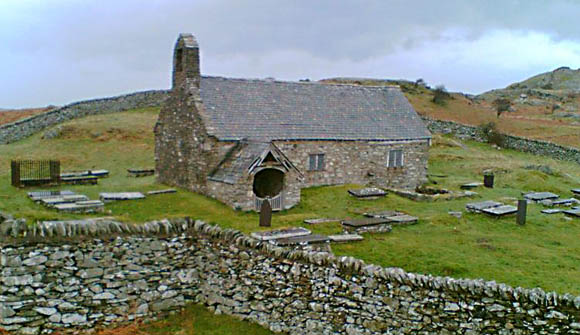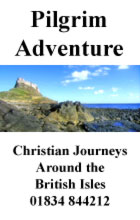Llangelynin (Welsh: The church of Celynin) is a former parish in the Conwy valley in north Wales. Today the name exists only in connection with the church, and the school in the nearby village of Henryd.
Note that modern usage prefers the spelling "Llangelynnin" (with a double n).
This church should not be confused with the ancient church of the same name which lies on the coast between Llwyngwril and Tywyn in the neighbouring county of Gwynedd.
Llangelynnin Church (Welsh: Eglwys Llangelynnin) is possibly one of the remotest churches in Wales, and is amongst the oldest; that at Llanrhychwyn, further up the valley, is a little older. A small and simple building, it probably dates from the 12th century (although some sources cite the 13th century), and lies at a height of just over 900' above the village of Henryd in the Conwy valley, in the shelter of Tal y Fan (610m), the hill to the south-west.
The church is dedicated to St. Celynin, who lived in the 6th century, and probably established the first religious settlement here. Llangelynin was also the name of the former parish, and the primary school in nearby Henryd (Ysgol Llangelynnin) still carries the name.
Location
Next to the church lie the remains of an ancient hut circle, and some stories romantically suggest that this was where St. Celynin himself lived. The church is overlooked from the north-east by the adjacent crags of Cerrig-y-ddinas, the site of an Iron Age fort. These crags afford wide views down the Conwy valley to the sea, and up the valley as far as Dolgarrog.
Many old paths lie in the area, and these routes would have been established at a time when the hills were considerably more wooded.
An old walled bridleway route leads east from the church, down through Parc Mawr, an area of woodland now owned by the Woodland Trust, who are replacing the 1960s-planted conifers with native species. The path through the wood leads towards the valley bottom, and to the west a route leads towards Penmaenmawr, past the Bronze Age standing stones of Maen Penddu. To the south-west a path meets the important Neolithic and Roman Road route passing through Bwlch-y-Ddeufaen, which connected the Conwy valley to the north coast near Llanfairfechan, and places further westwards.
The church building
The porch was added in the 15th century, and features an unusual "squint window" in its east (right) wall. Repairs to the porch roof were made using yew wood, and therefore it is quite possible that these came from the churchyard, which at one time contained trees. The door hinges and threshold date from the 14th century, although the door itself is more recent.
The nave is the oldest part of the church, dating from the 12th century, and the present chancel was added later, probably in the 14th century. Originally the nave would not have been paved, as it is today, and indeed, the rear of the north chapel remains unpaved even today. The roof contains dark oak rafters.
The north transcept was added in the the 15th century and was known as Capel Meibion, the "men's chapel". The window at the back of the chapel was a more recent addition.
Opposite the north trancept, a south trancept was also added, probably in the 16th century. This was called Capel Eirianws (meaning "Plum Orchard", the name of a local farm), whose owner possibly had it built. This chapel was demolished in the 19th century, but some remains are still visible from outside.
The present east window dates from the 15th century, and replaced a smaller 14th century window.
Since demolition of the south chapel (and the gallery) in the 19th century, the church has changed little.
Artifacts
The twisted altar rails and the alter screen date from the 17th century. The removal of a pulpit to the left of the altar revealed inscriptions on the east wall, and further removal of whitewash revealed the Creed, the Lord's Prayer and the Ten Commandments. These were written in Welsh. The inscription "Fear God and honour the King", together with scrollwork, can clearly be seen today, as can a skull and cross-bones! The Lord's Prayer, on the sill, is no longer visible.
The remains of the rood screen in front of the more recent lectern date from the 14th century, and would have separated the nave from the chancel. The church once had a rood loft and gallery, and the remains of these can be seen in on the nave walls, and from the beam at the back of the church. The gallery was demolished in the 19th century.
The reader's desk possibly dates from the 16th century, although the door is more recent.
The wooden benches in the nave date from the 18th century, although at least one bench in the church dates from 1629). One bench (at the front of the north chapel) still bears the initials R.O.B., this being the Reverend Owen Bulkeley, a former rector, who died in 1737. A church terrier of 1742 records a particular bench which was used by women only.
Just inside the church, on the wall, is a Holy Water stoup, used for making the sign of the Cross. This was used until the 19th century.
At the back of the church is an octagonal font, which probably dates from the 13th or 14th century.
The bell has no inscription and its date is therefore unknown.
On the wall in the nave is a bier, used to carry the dead to the churchyard.
Renovation
Major renovation of the church was carried out in 1932 and in 1987. This later renovation work was carried out under the guidance of Gerald Speechley, and a plaque in the church records this. He died three years later.
The churchyard
The churchyard is walled, with an arched entrance in the eastern wall. Today it is almost devoid of tree growth, but this was not always so.
The churchyard contains a fair number of gravestones, dating back to the 14th century. These graves were not dug in any uniform layout.
The Holy Well
In the south-eastern corner of the churchyard is a well - sometimes known as "The Holy Well of St. Celynin", and also by its Welsh name Ffynnon Gelynin - a small walled rectangular pool, which was renowned for its power to cure sick children. One old story relates that parents would throw items of their sick child's clothing into the water. If the clothes floated their child would live. If they sank the child was destined to die of the illness. The well was once roofed over but this no longer exists. The walls round the well, and probably the benches too, were later additions when the churchyard was restored. The presence of water at this elevation was probably the reason for its designation as a site for early settlement, and the well itself almost certainly predates the church.
Outside the churchyard
Outside the churchyard itself, close to the well, are the remains of a round building. A church terrier of 1742 refers to this, and to its use as a stable.
Beyond the south-east corner of the churchyard there was once an old inn. This was demolished in the 19th century.
The "new" church
Llangelynnin church was used regularly until 1840, when it closed following depopulation of the area. A new church was consequently built, carrying the same name, nearer the centres of population. This church is situated close to the 15th century Groes Inn (on the B5106), on the road which runs from the Inn to the village of Rowen. Whereas the old church reflects a simple Mediaeval design, the new church was designed by Thomas Jones of Chester in a much grander, lofty late Georgian style. Unusually, the tower has a square lower storey surmounted by an octagonal embattled upper stage. The original plans of 1839 still exist.
A plaque in the doorway refers to the "re-erection" of the building, implying perhaps that there was an earlier building on this site, but there is no evidence to this effect, and no gravestones pre-date 1839. The Religious Census of 1851 refers to it being erected in "1839 or 1840", but makes no reference to the Old Church.
This "new" church also eventually closed (in the 1980s), but the font from the church is now displayed by the altar in Llangelynnin old church.
Llangelynnin "new" church is now the studio of David Chapman, a sculptor and artist.
Access to the church
Despite its remoteness, the church is well signposted from Henryd, which lies off the B5106 south of Conwy. The single track road is metalled up to the small car park by the church. The church is not named on the Ordnance Survey map, but lies at reference SH751737.
The church is open to visitors on Saturdays (10 a.m. - 5 p.m.) and Sundays (2 - 4 p.m.).
Only occasionally are services held in the church, in the summer and on special occasions.
Llangelynnin - The wider parish
The following extract comes from A Topographical Dictionary of Wales (1849) by Samuel Lewis : LLANGELYNIN (LLAN-GELYNIN), a parish, in the union of Conway, hundred of Ll�chWedd-Is�v, county of Carnarvon, North Wales, 3 miles (S. by W.) from Conway; containing 270 inhabitants. This parish, which derives its name from the dedication of its church to St. Celynin, who flourished towards the close of the sixth century, is situated at the north-eastern extremity of the county, bordering upon Denbighshire. A memorable battle was fought at Cymryd, in or near the parish, in the year 880, between the forces of Anarawd, Prince of North Wales, and those of Edred, Earl of Mercia, who attempted the conquest of the country. In this conflict Anarawd was completely victorious; he drove the Mercians from the field of battle, and continued to pursue them until they were finally expelled from the principality: the victory was called Dial Rhodri, or "Roderic's revenge," as Anarawd thus fully avenged the slaughter of his father Roderic in a descent of the Saxons upon Anglesey. The village, which is small, is beautifully situated in a fertile vale under the mountain called T�l-y-Van. The surface of the parish is mountainous, the lands partially inclosed and cultivated, the soil various, and the surrounding scenery marked with features rather of boldness than of beauty. The living is a discharged rectory, rated in the king's books at �7; patron, the Bishop of Bangor. The incumbent's tithes have been commuted for a rent-charge of �250, and the glebe comprises five acres: a rent-charge of �5 is paid to the parish-clerk. The church is a small ancient edifice, in a state of considerable dilapidation. There are places of worship for Independents and Wesleyan Methodists; a day school in connexion with the Church, and a Sunday school belonging to the Independents. The Rev. Launcelot Bulkeley, in 1718, bequeathed �60, the interest to be paid to four widows, who are appointed at a vestry, and regularly receive the donation.
The following extact is taken from The National Gazetteer of Great Britain and Ireland (1868), transcribed by Colin Hinson. "LLANGELYNIN, a parish in the hundred of Isaf, county Carnarvon, 2 miles S.W. of Conway, its post town, and 10 E. of Llandegai. It is situated at the foot of the hill called Pen-maen-fach, and includes the townships of Cae-Gorlan, Cymryd, Glynn, and Pen-Raelt. The Saxons, under Edred, were defeated here by the Britons in 880. The living is a rectory in the diocese of Bangor, value �225, in the patronage of the bishop. The church is dedicated to St. Celynin. There are charities amounting to about �5 per annum. On the hills are several antiquities, including cairns, tumuli, etc."
|




